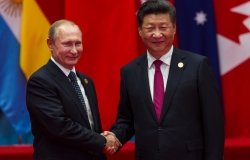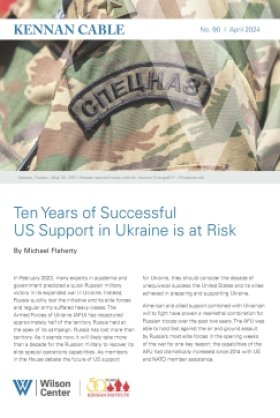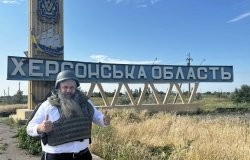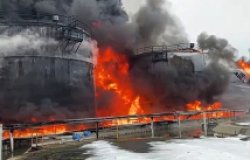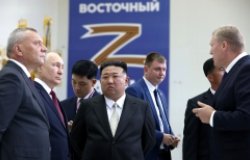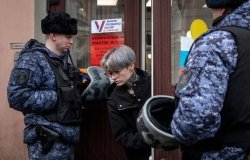Small Businesses in Russia: Property Rights and Investment
In his June 14 lecture at the Kennan Institute, Tim Frye, Assistant Professor, Department of Political Science, Ohio State University, discussed his recent examination of small business activities in Russia. Frye's research takes a micro-level focus on small business operations, in an effort get a handle on basic questions of governance--such as does market formation undermine or assist state formation? In his discussion, Frye covered the results of his research and analyzed investment trends and the security of property rights across three Russian cities--Moscow, Smolensk, and Ul'ianovsk.
In 1996 and 1998, Frye surveyed fifty to sixty small businesses in the three Russian cities, as well as in Warsaw and Columbus, Ohio, for comparison purposes. The businesses surveyed were typically retail shops that had from five to fifty employees. Frye noted that retail businesses were chosen because they operate in the real economy, as most of their transactions take place in cash rather than barter trade, and were feasible to survey on a small research budget. The business operators were asked a variety of basic questions regarding regulatory practices, investment decisions, corruption, etc. The form and content of the questions themselves were well researched to elicit the most truthful answers. In addition, sub-interviews with small businesses known to the researchers were conducted and compared with those of the unknown subjects.
Frye first briefly commented on the research results from the 1996 survey. This research showed that small businesses in Smolensk outperformed Moscow and Ul'ianovsk. In Smolensk, where the government was less intrusive and more pro-market as compared with Moscow and Ul'ianovsk, public services--including court systems and police--were provided at a much higher rate. In addition, the rate of major capital investment in small business was higher. Frye's research also showed that shops that faced a high level of regulation (i.e., were inspected frequently, or took a long time to register), as in Ul'ianovsk, were more likely to have contact with the private protection racket than shops that were less regulated. Highly regulated shops also felt that the provision of public services was dramatically lower than shops that faced regulation. Thus, the research from 1996 suggests that the development of a market and a state go hand-in-hand.
In 1998 roughly the same set of questions were asked as in 1996, with consistent results. Smolensk again performed better than Moscow or Ul'ianovsk. Impor-tantly, the research also suggests that market compe-tition was an important catalyst for investment in these cities--the shops that faced an intensely competitive economic environment tended to invest more and believed the security of their property rights was greater.
In his research, Frye was interested in trying to identify factors involved in small business investment decisions, thereby identifying sources of secure property rights--Frye's assumption being that businesses are more likely to invest if they have firm property rights. Frye noted that property rights in turn are important for overall economic growth and arguably for democracy. In an attempt to gauge their investment decisions, small business operators were asked three questions regarding investment in their business--whether they had made a major capital investment in their business, the rate of reinvestment of profits, and whether they based their investment decisions on state policy. In Smolensk and Warsaw, more small businesses made major capital investments in their operations than in Moscow or Ul'ianovsk. However, surprisingly, the rate of reinvestment of profits in Ul'ianovsk was higher than the other cities, although Smolensk also performed well. In Smolensk it was rare not to make an investment due to state policy, whereas it was more frequent in Moscow and Ul'ianovsk.
Frye explained this variation in investment by analyzing the different cities' results with respect to regulation, corruption, and public services (here the courts). Frye noted that in cities where regulation is high, shops tend to invest at a lower rate, simply because it is more costly to invest. The level of regulation was much higher in Ul'ianovsk than in Smolensk, whose local government was far less intrusive. Regarding the courts, more shops in Ul'ianovsk felt they had come up against a conflict where the courts should have been used but decided not to, which provides evidence of the poor performance of the courts--the business's legal safeguard. Moreover, in Ul'ianovsk and Moscow, businesses felt more legally vulnerable, as compared to Smolensk and Warsaw. Corruption was a greater problem and shops were also more likely to have had contact with the racket in Ul'ianovsk.
Through statistical analysis Frye found that of these factors--regulation, corruption, faith in the courts--one of the most important influences on a small business operator's decision to invest was the extent to which they felt legally vulnerable. Frye believed this sense of legal vulnerability is a sense of how vulnerable they are to private protection rackets. Frye emphasized again that another important factor was the intensity of market competition for investment, which implies that by reducing barriers to entry and making market competition a bigger priority, investment and the security of property rights would be increased.
About the Author
Allison Abrams
Read More
Kennan Institute
The Kennan Institute is the premier US center for advanced research on Russia and Eurasia and the oldest and largest regional program at the Woodrow Wilson International Center for Scholars. The Kennan Institute is committed to improving American understanding of Russia, Ukraine, Central Asia, the Caucasus, and the surrounding region though research and exchange. Read more
